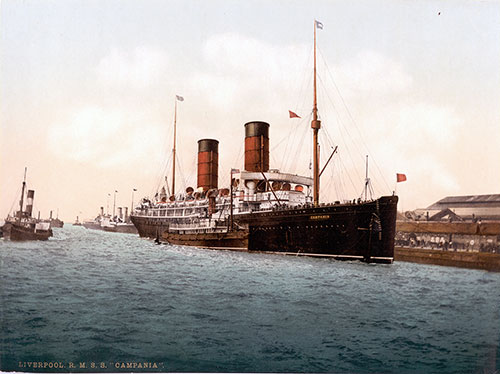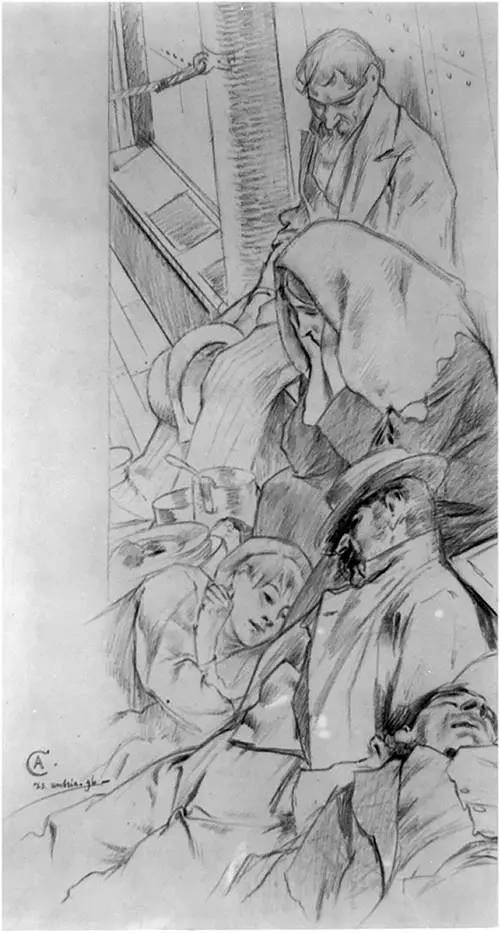Life in the Steerage on the RMS Campania - 1895

RMS Campania of the Cunard Line on the River Mersey circa 1900. Library of Congres # 2002708357. GGA Image ID # 141424d301
The arrangements for steerage passengers on one of the best ocean steamers, the Campania, are as follows. The steerage quarters, which are situated on the lower deck, are divided into seven different sleeping apartments for the accommodation of some 700 or 800 passengers.
There are separate apartments for the single men, single women, and married couples. The five apartments for the use of the two first-named classes are equipped with from 60 to 110 berths, measuring 6 1/2 ft. by 2 1/2 ft., which are built close together and arranged in tiers of two in the center of each steerage.
These berths are constructed of adjustable galvanized iron piping, thus preventing the accumulation of dirt so common in the case of the old wooden berths.
Each passenger is provided with a clean straw mattress and a heavy rough blanket. Each time the steamer reaches port the old mattresses are burned, and new ones taken on board, while the blankets are thoroughly washed and cleansed before the return voyage.
The quarters for married people are aft, on the lower deck, in a "pocket" on either side of the vessel. Each of these pockets is divided into some twenty state rooms, each holding from two to six berths, which are furnished in the way already described.
All the forward steerages extend across the entire width of the deck, are approachable by two entrances, and are well ventilated. The “pockets,” which are confined to either the port or starboard side of the vessel, are less roomy and have only one entrance to each.
The arrangements for ventilation in the steerage are exceptionally good on this ship. Besides the ventilation obtained from the hatchways and from the large flue ventilators a new ventilating attachment has been placed upon each porthole.
It is generally necessary to close the portholes if the voyage is at all rough. This is done by fastening a heavy inch-and a-half plate-glass cap over the hole, which lets in the light.
Just outside the glass cap on the top of the porthole are several small openings for ventilation. Each one of these openings is provided with a cork so placed on the inside as to allow the air to pass in, but should a heavy wave strike the porthole the force of the breaker drives the cork to its place, closing the openings for ventilation until the wave retreats.
The passengers eat their three meals a day sitting on long rows of benches arranged before narrow shelves fastened to the sides of the vessel in the sleeping apartments.

Charcoal Drawing of Immigrants in Steerage on the RMS Umbria of the Cunard Line - 1898. Library of Congress # 2010715345. GGA Image ID # 141425cc11
Each emigrant is provided on boarding the ship with a plate of heavy crockery, a. knife, fork, spoon, and tin cup. These articles everyone is supposed to care for and keep clean during the voyage.
After each meal, a big pan of water is placed upon the floor in each of the steerages as a common cleansing place for all the dishes. In fact, however, less than one-third of the passengers ever take the trouble to wash their dishes.
Two light and airy hospitals, holding twelve beds each, are situated on the main deck for the use of the sick. The steerage passenger medical officer attends to all cases of illness among the passengers.
He is required to punch the inspection card of each emigrant daily after each examination, which is a guarantee to the inspection officers at the Immigration Bureau that the passenger has had no contagious disease.
On a certain day during the voyage all the steerage passengers are mustered on deck by order of the ship's medical officer to pass the vaccination examination. If they are found to have been properly vaccinated, they receive a certificate to that effect; if not, they are put on one side for subsequent treatment.
October 16th 1895
The Lancet: A Journal of British and Foreign Medicine, Surgery, Obstetrics, Physiology, Chemistry, Pharmacology, Public Health, and News., London, 1895 Volume II, 2 November 1895, p.1142
